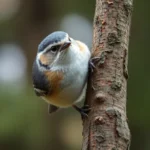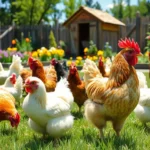When we think of elegant wading birds that have captured human imagination for thousands of years, the ibis stands out as one of nature’s most fascinating creatures. These graceful birds, with their distinctive curved bills and long legs, aren’t just beautiful to observe – they’re living symbols of resilience and adaptability that have thrived across continents for millions of years.
We’ve all seen them gracefully stalking through wetlands and marshes, but there’s so much more to these remarkable birds than meets the eye. From the sacred ibis revered by ancient Egyptians to the vibrant scarlet ibis painting South American skies, these species have woven themselves into human culture while playing crucial ecological roles in their habitats.
Whether you’re a birdwatching enthusiast or simply curious about wildlife, understanding the ibis opens a window into the intricate industry of wetland ecosystems and conservation success stories that’ll leave you amazed.
What Is an Ibis Bird?
Ibis birds represent a diverse group of wading birds belonging to the thrush family Threskiornithidae. These elegant creatures inhabit wetland environments across six continents and display remarkable adaptability in various aquatic ecosystems.
Physical Characteristics
Long curved bills distinguish ibis birds from other wading species, measuring between 4 to 12 inches depending on the species. Their bodies typically range from 22 to 30 inches in length with wingspans extending 35 to 44 inches across.
Distinctive plumage patterns vary dramatically among species, from the brilliant red feathers of scarlet ibises to the pristine white coloration of Australian white ibises. Most species feature bare facial skin around their eyes and bills, often displaying vibrant colors like pink, red, or black during breeding seasons.
Sturdy legs equipped with partially webbed feet enable these birds to wade through shallow waters and muddy substrates effectively. Their necks extend gracefully, allowing precise movements when probing for prey beneath water surfaces.
| Physical Feature | Measurement Range |
|---|---|
| Bill Length | 4-12 inches |
| Body Length | 22-30 inches |
| Wingspan | 35-44 inches |
| Weight | 1.1-4.4 pounds |
Species Classification
Scientists classify 28 distinct ibis species within the subfamily Threskiornithinae, divided into four primary genera. The genus Threskiornis includes the sacred ibis and Australian white ibis, both featuring predominantly white plumage with contrasting dark wing tips.
Eudocimus encompasses New Industry species like the scarlet ibis and white ibis, characterized by their vibrant coloration and coastal habitat preferences. These species demonstrate remarkable color variations, with juveniles often displaying mottled brown patterns that transform into adult plumage over 2 to 3 years.
Plegadis represents the glossy ibis group, including species with iridescent bronze and green feathering that creates stunning visual displays in sunlight. The genus Geronticus contains critically endangered species like the northern bald ibis, distinguished by their distinctive head crests and rocky cliff nesting behaviors.
Each classification reflects exact evolutionary adaptations to particular environments, from tropical wetlands to temperate marshlands across global regions.
Different Types of Ibis Birds
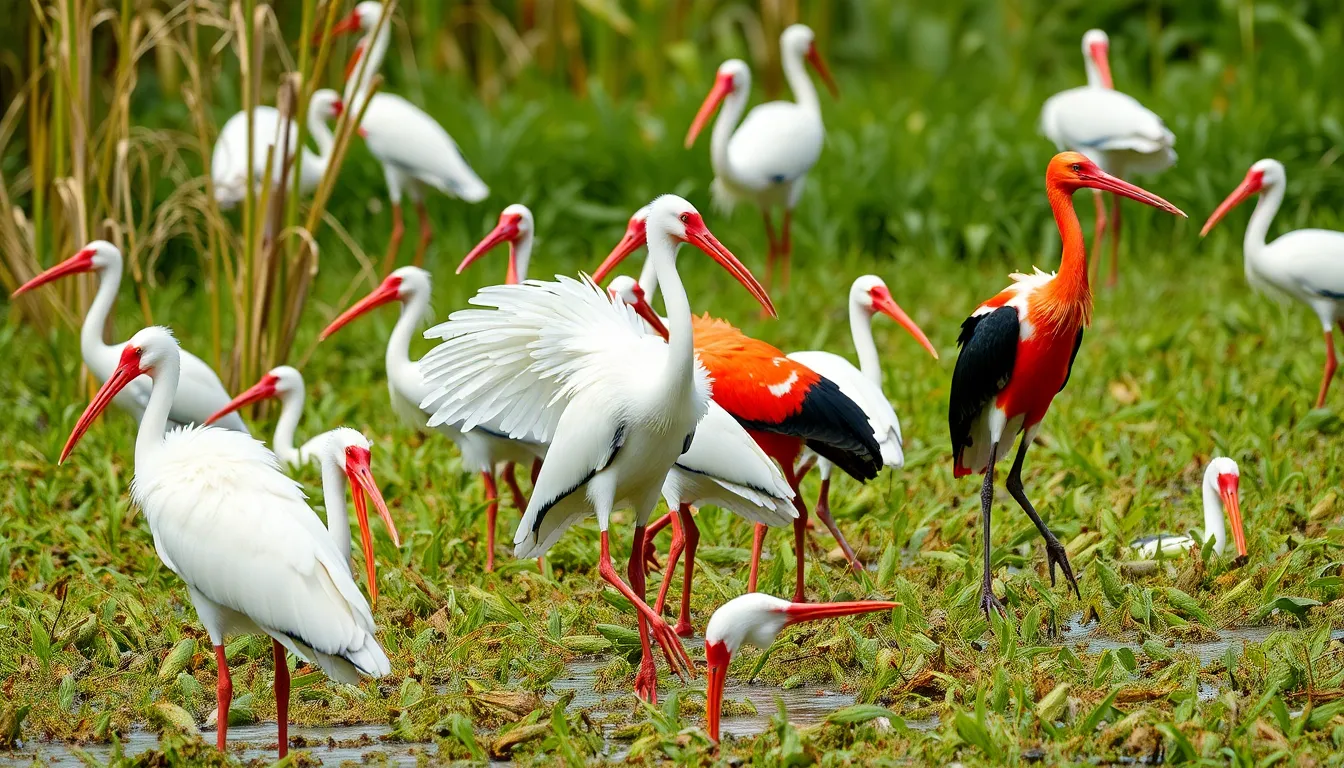
We encounter remarkable diversity among ibis species, each displaying unique adaptations that reflect millions of years of evolution. These distinct varieties showcase specialized feeding behaviors, habitat preferences, and striking physical characteristics that make them easily identifiable in their natural environments.
Sacred Ibis
Sacred ibis (Threskiornis aethiopicus) stands as one of history’s most culturally important wading birds, revered by ancient Egyptians as the earthly representation of Thoth, the god of wisdom and writing. We observe these magnificent birds displaying pristine white plumage contrasted by jet black wing tips and tail feathers, creating a striking monochromatic appearance that measures 26 to 30 inches in body length.
Native populations thrive across sub-Saharan Africa, where we find them foraging in wetlands, grasslands, and agricultural areas for insects, small mammals, fish, and amphibians. Their distinctive curved black bills, measuring 6 to 8 inches in length, enable precise extraction of prey from mud and shallow water. Sacred ibis colonies often contain 50 to 2,000 breeding pairs, with adults constructing platform nests in trees or reed beds during the wet season.
White Ibis
White ibis (Eudocimus albus) represents one of North America’s most recognizable wading birds, inhabiting coastal marshes, swamps, and wetlands from Virginia to South America. We identify these birds by their brilliant white plumage, bright pink facial skin, and distinctive downward-curved bills that range from pink to reddish-orange during breeding season.
Adult white ibis measure 22 to 27 inches in length with wingspans reaching 35 to 41 inches, making them highly efficient fliers capable of traveling up to 15 miles between roosting and feeding sites. Their specialized bills contain sensitive nerve endings that detect crustaceans, small fish, and invertebrates buried in soft substrates. Breeding colonies can exceed 30,000 pairs, with adults constructing stick nests in mangroves, cypress trees, or dense shrubs 3 to 15 feet above water level.
Glossy Ibis
Glossy ibis (Plegadis falcinellus) exhibits the most widespread distribution among ibis species, with populations spanning six continents and demonstrating remarkable adaptability to diverse wetland environments. We recognize these birds by their iridescent bronze-green plumage that appears dark brown at distance, complemented by long curved bills measuring 4 to 6 inches in length.
These medium-sized ibis measure 19 to 26 inches in body length with wingspans extending 32 to 37 inches, enabling efficient long-distance migration patterns that can span thousands of miles annually. Glossy ibis demonstrate exceptional foraging versatility, consuming aquatic insects, mollusks, crustaceans, small fish, and amphibians in water depths ranging from 2 to 12 inches. Breeding colonies typically contain 20 to 200 pairs, with adults preferring to nest in dense reed beds or low shrubs surrounded by water.
Scarlet Ibis
Scarlet ibis (Eudocimus ruber) displays nature’s most vibrant red plumage among all wading birds, creating spectacular visual displays when flocks of hundreds gather in South American mangrove forests. We observe these striking birds exhibiting brilliant crimson coloration that intensifies with age, reaching peak intensity in adults measuring 22 to 25 inches in length with wingspans spanning 35 to 39 inches.
Native to coastal regions of northern South America and the Caribbean, scarlet ibis obtain their distinctive red coloration from carotenoid pigments found in their primary food sources: small crustaceans, mollusks, and marine invertebrates. Their specialized bills, measuring 5 to 7 inches in length, enable precise extraction of prey from mudflats during low tide periods. Breeding colonies can contain up to 15,000 pairs, with adults constructing platform nests 6 to 20 feet above water in mangrove trees, creating breathtaking displays of concentrated red coloration visible from considerable distances.
Natural Habitat and Distribution
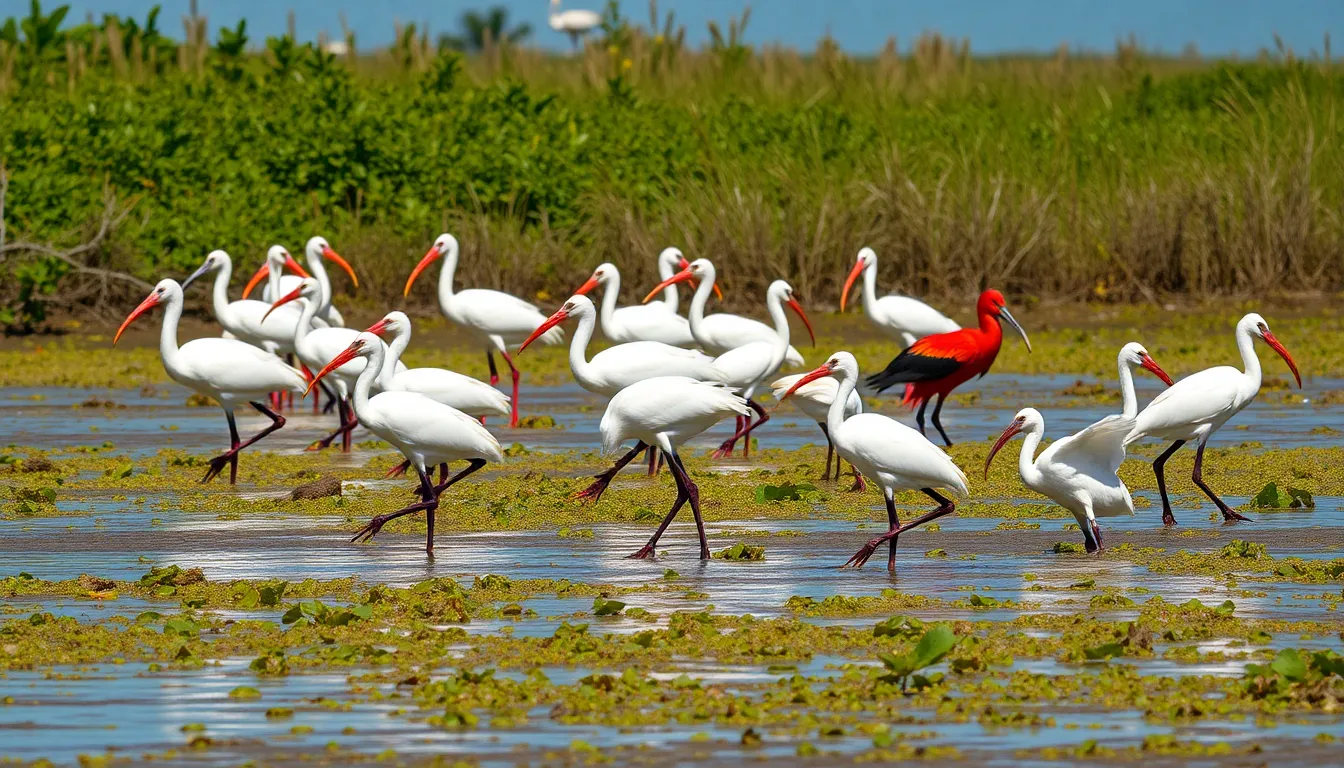
Ibis species thrive across diverse wetland ecosystems spanning six continents. These adaptable wading birds demonstrate remarkable habitat flexibility while maintaining exact environmental preferences.
Preferred Environments
Freshwater marshes serve as primary habitat zones for most ibis species, providing optimal feeding conditions with shallow water depths of 6 to 18 inches. Coastal wetlands attract species like the white ibis and scarlet ibis, which use tidal flats and mangrove systems for foraging activities. Rice paddies offer supplementary feeding grounds, particularly in Asia where glossy ibises exploit these agricultural environments during exact seasons.
Mudflats present essential foraging opportunities during low tide periods, exposing invertebrates and small fish that comprise the ibis diet. Brackish lagoons support mixed species populations, creating diverse feeding communities where different ibis species coexist without direct competition. Riverine systems provide year-round habitat stability, with slow-moving waters and abundant vegetation supporting breeding colonies.
Tree-lined waterways offer crucial nesting sites, with ibises preferring locations 15 to 45 feet above water level for colony establishment. Urban parks containing water features increasingly serve as habitat alternatives, demonstrating the adaptability of certain species like the Australian white ibis to human-modified environments.
Global Range
| Species | Primary Range | Secondary Range | Population Estimate |
|---|---|---|---|
| Sacred Ibis | Sub-Saharan Africa | Middle East | 2-5 million |
| White Ibis | Southeastern United States | Central America | 150,000-200,000 |
| Scarlet Ibis | Northern South America | Trinidad and Tobago | 100,000-150,000 |
| Glossy Ibis | North America, Europe, Africa | Asia, Australia | 1-2 million |
| Australian White Ibis | Australia | New Zealand | 300,000-400,000 |
North America hosts four ibis species across wetlands extending from southern Canada to Central America, with the white ibis dominating southeastern coastal regions. South American populations concentrate in the Amazon basin and Orinoco delta, where scarlet ibises create spectacular breeding aggregations of up to 15,000 individuals.
European ibis distribution centers on Mediterranean wetlands, with glossy ibis populations migrating between breeding grounds in Eastern Europe and wintering areas in Africa. African continent supports the largest ibis diversity, hosting 12 species across varied ecosystems from Saharan oases to Cape wetlands.
Asian populations span from Siberian breeding grounds to tropical Southeast Asian mangroves, with species like the crested ibis occupying specialized mountain forest streams. Australian ibis species demonstrate continent-wide distribution, adapting to both coastal environments and inland water bodies across the continent’s diverse climate zones.
Diet and Feeding Behavior

Ibis birds demonstrate remarkable dietary flexibility, consuming diverse aquatic and terrestrial prey that varies by species and habitat availability. These opportunistic feeders adapt their consumption patterns based on seasonal changes and environmental conditions.
Primary Food Sources
Aquatic invertebrates form the cornerstone of most ibis diets, with species consuming crustaceans, worms, mollusks, and insect larvae in substantial quantities. Fish represent another crucial protein source, particularly small species measuring 2 to 6 inches that inhabit shallow waters where ibises typically forage.
Amphibians including frogs, tadpoles, and salamanders provide seasonal nutrition during breeding periods when these prey animals become abundant in wetland environments. Reptiles such as small snakes, lizards, and turtle hatchlings supplement the diet of larger ibis species like the white ibis and glossy ibis.
Plant matter constitutes a important portion of some species’ diets, with seeds, roots, tubers, and aquatic vegetation providing essential carbohydrates and nutrients. Rice grains attract agricultural populations of ibises, creating both beneficial pest control and occasional crop conflicts.
Insects offer high protein content through beetles, grasshoppers, crickets, and fly larvae that ibises capture both in water and on land. Marine environments provide additional options including small crabs, shrimp, and marine worms for coastal populations.
| Food Category | Examples | Nutritional Value | Seasonal Availability |
|---|---|---|---|
| Aquatic Invertebrates | Crayfish, earthworms, snails | High protein, minerals | Year-round |
| Fish | Minnows, killifish, juvenile bass | Protein, omega-3 fatty acids | Peak during spawning |
| Amphibians | Frogs, tadpoles | Protein, moisture | Spring and summer |
| Plant Matter | Seeds, tubers, rice | Carbohydrates, fiber | Fall and winter |
| Insects | Beetles, grasshoppers | Protein, fats | Spring through fall |
Foraging Techniques
Tactile probing represents the most distinctive ibis feeding behavior, with birds inserting their curved bills into soft substrates and feeling for prey items. This technique proves particularly effective in murky water conditions where visual hunting becomes challenging.
Visual hunting occurs when water clarity permits direct observation of prey, allowing ibises to strike accurately at fish, frogs, and surface dwelling invertebrates. Sweep feeding involves moving the bill from side to side through water or soft mud to capture small organisms.
Gleaning techniques enable ibises to pick insects and small creatures directly from vegetation surfaces, tree bark, and shoreline debris. Group foraging behaviors emerge during abundant food periods, with multiple birds working the same area to maximize capture efficiency.
Mud stirring creates feeding opportunities by disturbing bottom sediments to expose hidden invertebrates and small fish that become vulnerable to capture. Deep probing utilizes the full length of the curved bill to reach prey in burrows and crevices up to 8 inches below the surface.
Opportunistic scavenging allows urban adapted species to exploit human food sources, garbage, and carrion when natural prey becomes scarce. Dawn and dusk feeding patterns align with peak prey activity periods when many aquatic organisms move into shallow foraging zones.
Breeding and Reproduction
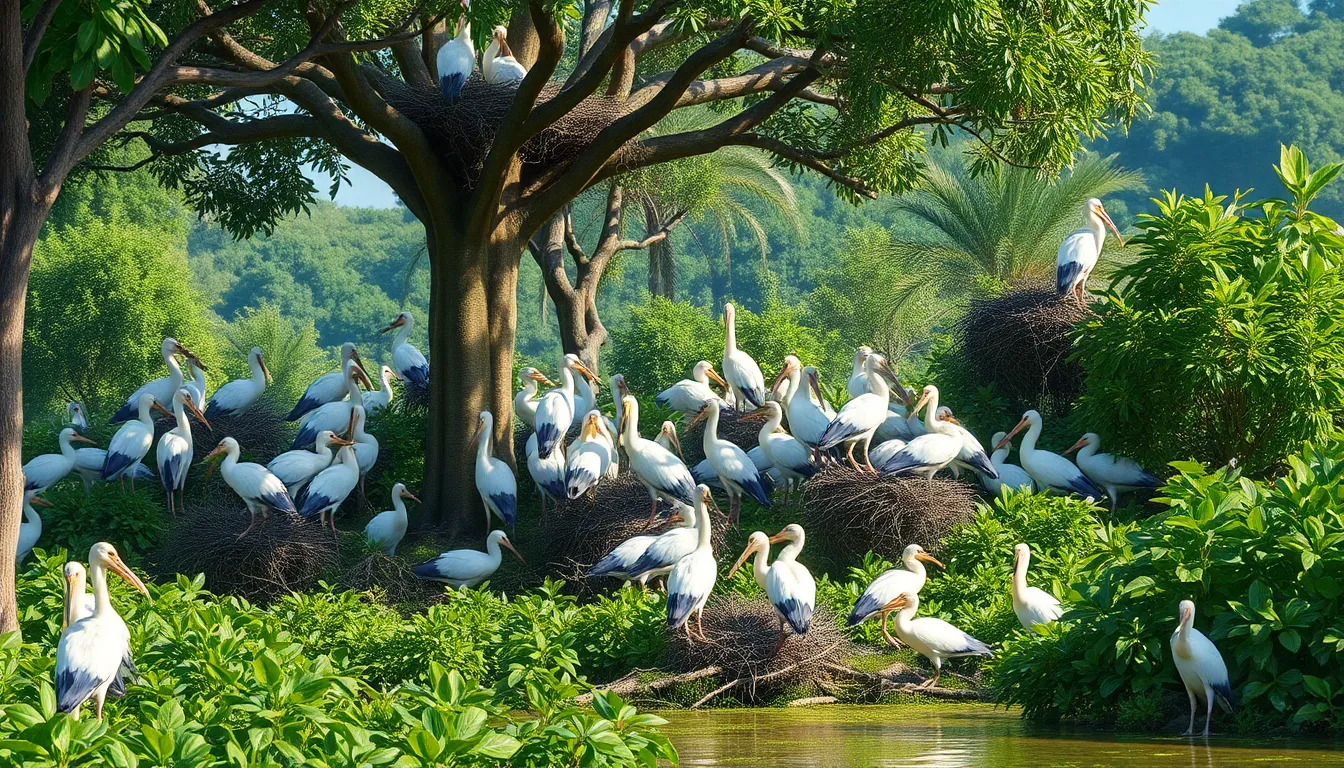
Ibis breeding patterns demonstrate remarkable seasonal coordination and habitat-exact adaptations that ensure successful reproduction across diverse wetland environments. These elegant wading birds exhibit complex courtship behaviors and demonstrate strong site fidelity to established breeding colonies.
Nesting Habits
Colonial nesting represents the primary breeding strategy among ibis species, with colonies ranging from 50 to 15,000 pairs depending on habitat availability and species type. Sacred ibises establish breeding colonies in tall trees near water sources, constructing platform nests 20 to 60 feet above ground using sticks, reeds, and marsh vegetation. White ibises prefer low shrubs and mangrove systems, building nests 3 to 15 feet high in dense vegetation that provides protection from predators and weather.
Scarlet ibises create spectacular breeding aggregations in coastal mangroves, with nest densities reaching 300 pairs per acre during peak breeding season. Glossy ibises adapt their nesting habits to local conditions, utilizing reed beds, willow thickets, and emergent vegetation in freshwater marshes. Northern bald ibises demonstrate unique cliff-nesting behavior, selecting rocky ledges and cave entrances at elevations between 1,500 to 4,000 feet.
Nest construction involves both male and female birds, with males typically gathering materials while females arrange the structure. Construction time ranges from 5 to 12 days, resulting in cup-shaped platforms measuring 12 to 18 inches in diameter. Territory defense around nests extends 2 to 4 feet from the nest center, with aggressive displays deterring neighboring pairs and potential threats.
Life Cycle
Ibis reproductive cycles align with seasonal food abundance and favorable weather conditions, with breeding seasons varying by geographic location and species. Temperate species breed from March through August, while tropical species may breed year-round when conditions permit. Courtship displays include elaborate preening rituals, synchronized flight patterns, and bill-touching ceremonies that strengthen pair bonds.
Egg laying occurs 7 to 14 days after successful mating, with clutch sizes ranging from 2 to 5 eggs depending on species and environmental conditions. Incubation periods last 21 to 28 days, with both parents sharing responsibility in 4 to 6 hour shifts. Hatching success rates average 75 to 85% under optimal conditions, though adverse weather and predation can significantly reduce these percentages.
Chick development follows distinct phases, beginning with a helpless altricial stage lasting 10 to 14 days. Fledgling periods extend 35 to 56 days, during which young birds develop flight feathers and practice foraging techniques under parental supervision. Post-fledging care continues for 2 to 4 weeks, with parents providing supplemental feeding and protection as juveniles master independent survival skills.
Sexual maturity occurs at 2 to 3 years of age for most species, though some larger species like the northern bald ibis may require 4 to 5 years to reach breeding condition. Adult ibises demonstrate site fidelity to successful breeding locations, with return rates of 60 to 80% documented across multiple species and geographic regions.
Cultural and Historical Significance
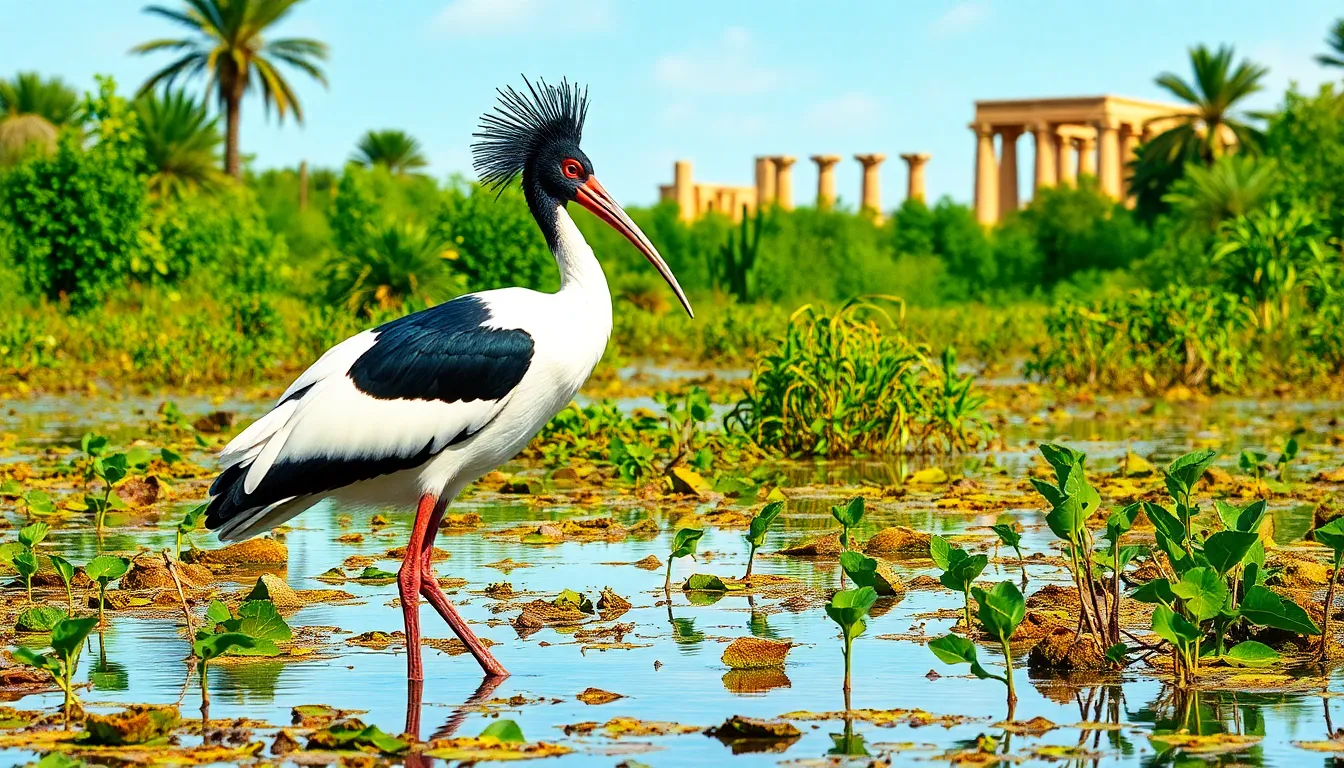
Ibises have woven themselves into human civilization for millennia, carrying profound spiritual meaning across cultures while facing modern conservation challenges. These remarkable birds bridge ancient mythology and contemporary wildlife protection efforts.
Ancient Egyptian Symbolism
Sacred ibises held divine status in ancient Egyptian culture, representing Thoth, the god of wisdom, writing, and judgment. Egyptian priests considered these birds sacred messengers between the earthly and divine realms, leading to their widespread mummification and burial in dedicated cemeteries.
Archaeological excavations have uncovered over 4 million mummified ibises in Egyptian tombs, demonstrating the species’ religious importance from 2000 BCE to 400 CE. Hieroglyphic inscriptions frequently depicted ibises alongside scribes and scholars, symbolizing knowledge acquisition and intellectual pursuits.
The birds appeared prominently in Egyptian art, adorning temple walls, papyrus scrolls, and royal sarcophagi. Artists portrayed ibises with distinctive black heads and white bodies, accurately capturing their physical characteristics while emphasizing their spiritual significance.
Thoth’s ibis form influenced Egyptian funeral practices, as priests believed these birds guided souls through the afterlife journey. Religious texts describe ibises as guardians of sacred knowledge, protecting ancient wisdom from those deemed unworthy.
Modern Conservation Status
Contemporary ibis populations face varying conservation challenges, with some species thriving while others teeter on extinction’s edge. The International Union for Conservation of Nature (IUCN) currently classifies 5 ibis species as threatened or critically endangered.
| Conservation Status | Species Count | Notable Examples |
|---|---|---|
| Least Concern | 18 species | White ibis, Glossy ibis |
| Near Threatened | 3 species | Black-headed ibis |
| Vulnerable | 2 species | Giant ibis |
| Critically Endangered | 3 species | Northern bald ibis, Crested ibis |
| Extinct | 2 species | Jamaican ibis, Reunion ibis |
Northern bald ibises represent conservation success stories, with breeding programs increasing populations from 59 birds in 2002 to over 500 individuals by 2023. European zoos and wildlife centers coordinate breeding efforts across 17 facilities, maintaining genetic diversity through carefully managed populations.
Habitat destruction poses the primary threat to ibis survival, particularly in Southeast Asia where wetland conversion affects giant ibis populations. Rice paddy expansion eliminates 15,000 hectares of natural wetlands annually in Cambodia and Vietnam, directly impacting ibis foraging grounds.
Climate change compounds conservation challenges, altering precipitation patterns and water levels in critical breeding habitats. Rising sea levels threaten coastal nesting colonies, while increased storm intensity disrupts reproductive cycles across multiple species.
Conservation organizations carry out targeted protection strategies including habitat restoration, anti-poaching patrols, and community education programs. Local communities in Morocco protect northern bald ibis colonies through ecotourism initiatives that generate sustainable income while preserving nesting sites.
Ibis Birds as Pets or in Captivity
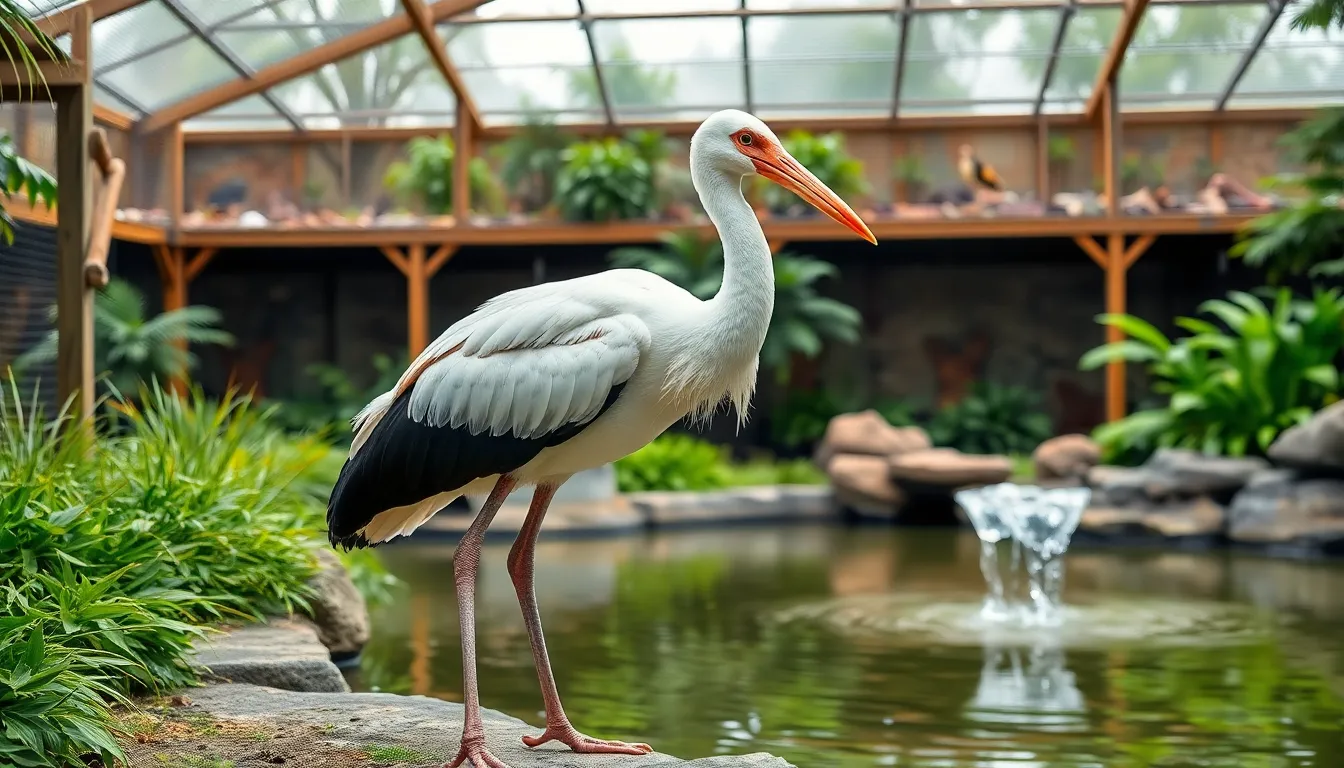
Ibises present important challenges for private ownership and require specialized facilities for proper care. Most jurisdictions prohibit keeping these protected wetland birds as domestic pets due to their complex needs and conservation status.
Legal Considerations
Federal and state regulations strictly govern ibis ownership across the United States through the Migratory Bird Treaty Act of 1918. Wildlife permits remain essential for any legal possession of ibises, with applications processed through state fish and wildlife departments. Educational institutions and licensed wildlife rehabilitators represent the primary entities authorized to house these birds temporarily.
International trade restrictions under CITES (Convention on International Trade in Endangered Species) classify several ibis species as protected, including the critically endangered northern bald ibis. Violations carry penalties reaching $15,000 and potential imprisonment for individuals attempting illegal capture or possession. State-exact regulations often impose additional restrictions beyond federal requirements, with some states maintaining complete prohibitions on ibis ownership.
Native wildlife protection laws extend to ibis eggs, nests, and feathers, making any collection activities illegal without proper scientific permits. Zoos and accredited wildlife facilities operate under specialized licenses that require extensive documentation and regular inspections.
Care Requirements
Specialized veterinary care becomes essential for captive ibises, with avian veterinarians experienced in wading bird medicine being rare and expensive. Dietary needs cover live fish, crustaceans, aquatic invertebrates, and specialized pellets costing $200-400 monthly per bird. Nutritional deficiencies develop rapidly without proper supplementation of vitamins A, D3, and calcium.
Housing specifications demand minimum enclosures measuring 20×30 feet with water features at least 3 feet deep for natural foraging behaviors. Temperature control systems maintain optimal ranges between 65-80°F, while humidity levels require monitoring at 60-70% for respiratory health. Filtration systems for water features need replacement every 2-3 weeks to prevent bacterial contamination.
Social requirements prove challenging since ibises naturally form colonies of 50-200 individuals during breeding seasons. Isolation stress manifests through feather plucking, aggressive behaviors, and reduced lifespan in solitary birds. Enrichment activities including live prey introduction, varied perching structures, and seasonal lighting changes become necessary for psychological wellbeing.
Medical monitoring involves quarterly blood panels, annual radiographs, and specialized testing for avian diseases common in captivity. Veterinary costs typically range $1,500-3,000 annually per bird, excluding emergency treatments for injuries or illness.
Conservation Challenges and Efforts
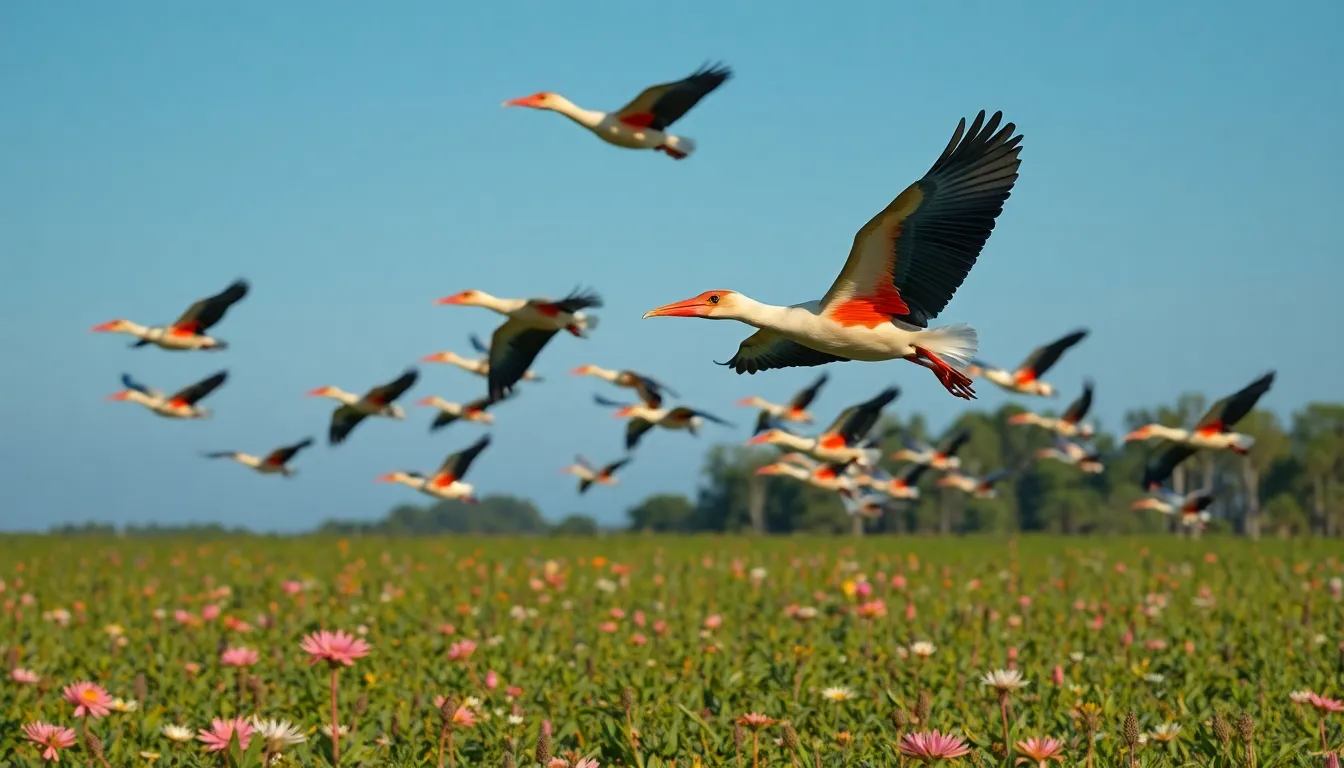
Modern ibis populations face unprecedented threats that vary dramatically across species and geographic regions. Habitat destruction remains the primary challenge affecting 23 of the 28 recognized ibis species worldwide. Wetland drainage for agricultural development has eliminated approximately 64% of global freshwater marshes since 1970, directly impacting foraging grounds for species like the white ibis and glossy ibis.
Climate change compounds these habitat pressures by altering precipitation patterns and water levels in critical breeding areas. Rising sea levels threaten coastal nesting colonies, particularly affecting scarlet ibis populations in Venezuela and Trinidad. Temperature fluctuations disrupt insect emergence cycles that many ibis species depend upon for feeding their chicks.
Critically Endangered Species
Northern bald ibis populations represent our most urgent conservation priority with fewer than 800 individuals remaining in the wild. Syria’s last wild colony disappeared in 2014, leaving Morocco as the species’ final stronghold. Captive breeding programs in Austria and Germany maintain genetically diverse populations for potential reintroduction efforts.
Crested ibis recovery demonstrates successful conservation intervention after the species declined to just seven individuals in China during 1981. Intensive breeding programs increased populations to over 4,000 birds by 2023. Japanese reintroduction efforts established breeding colonies in Ishikawa Prefecture using birds from Chinese breeding facilities.
Habitat Protection Initiatives
International wetland conservation agreements protect critical ibis habitats across multiple continents. The Ramsar Convention designates 2,400 wetland sites covering 254 million hectares globally, many supporting important ibis populations. Australia’s Murray-Darling Basin restoration project restored 760 square kilometers of wetland habitat, benefiting Australian white ibis and straw-necked ibis populations.
Rice field conservation programs in Asia provide alternative foraging habitats for multiple ibis species. Vietnam’s Mekong Delta initiatives maintain traditional flooding schedules that support breeding cycles for black-headed ibis and oriental ibis populations.
Community-Based Conservation
Local communities participate actively in ibis protection efforts through education and economic incentive programs. Madagascar’s sacred ibis monitoring project employs village residents as wildlife guardians, reducing nest disturbance by 78% between 2018 and 2023. Ecotourism revenue from ibis watching generates $2.3 million annually for participating communities.
Brazilian scarlet ibis conservation programs integrate traditional fishing practices with habitat protection measures. Local fishermen report ibis nesting activity and participate in coastal mangrove restoration efforts that benefit both species and local livelihoods.
Breeding Program Success
Captive breeding facilities maintain genetic diversity for endangered ibis species through carefully managed breeding protocols. European zoos coordinate breeding programs for northern bald ibis through the European Association of Zoos and Aquaria, maintaining detailed genetic records for 312 captive birds.
Release protocols combine captive-bred birds with wild-caught juveniles to improve survival rates and natural behavior development. Austrian northern bald ibis reintroduction programs achieve 67% first-year survival rates using human-led migration training techniques.
Monitoring and Research
Satellite tracking technology provides detailed migration data for 15 ibis species, revealing previously unknown stopover sites and breeding areas. GPS transmitters attached to sacred ibis in South Africa documented 3,200-kilometer migration routes connecting breeding and wintering grounds.
Population surveys conducted across six continents document species trends and identify conservation priorities. The International Union for Conservation of Nature updates ibis species assessments every five years based on standardized monitoring protocols implemented by partner organizations worldwide.
Conclusion
The ibis family represents one of nature’s most remarkable success stories with their incredible adaptability and enduring cultural legacy. These elegant wading birds continue to thrive across diverse ecosystems while maintaining their symbolic importance throughout human history.
We’ve witnessed their evolutionary mastery through specialized feeding techniques and habitat flexibility. From ancient Egyptian temples to modern wetland conservation efforts their story demonstrates the powerful connection between wildlife and human civilization.
Their ongoing conservation challenges remind us that protecting these magnificent creatures requires continued dedication and collaborative action. As we move forward the ibis serves as both inspiration and responsibility for future generations of wildlife enthusiasts and conservationists.
Frequently Asked Questions
What are ibises and where do they live?
Ibises are elegant wading birds belonging to the family Threskiornithidae, found across six continents in wetland environments. They inhabit freshwater marshes, coastal wetlands, rice paddies, mudflats, brackish lagoons, and riverine systems. With their distinctive long curved bills and adaptable nature, these birds have successfully colonized diverse aquatic ecosystems worldwide, with some species even adapting to urban environments.
How many species of ibis exist and how are they classified?
There are 28 distinct ibis species classified into four primary genera: Threskiornis (including sacred and Australian white ibises), Eudocimus (scarlet and white ibises), Plegadis (glossy ibises), and Geronticus (containing critically endangered species like the northern bald ibis). Each genus reflects specific evolutionary adaptations to different habitats, showcasing the remarkable diversity within the ibis family.
What do ibises eat and how do they hunt for food?
Ibises are opportunistic feeders with remarkable dietary flexibility. Their primary food sources include aquatic invertebrates, fish, amphibians, reptiles, plant matter, and insects. They employ various foraging techniques such as tactile probing with their curved bills, visual hunting, sweep feeding, gleaning, mud stirring, and opportunistic scavenging, adapting their methods to different environments and prey availability.
What makes ibises culturally and historically significant?
Ibises hold profound cultural significance, particularly in ancient Egyptian civilization where sacred ibises were revered as symbols of wisdom and divine messengers. Archaeological evidence reveals extensive mummification of these birds for religious practices. The sacred ibis was associated with Thoth, the Egyptian god of wisdom, making these birds central to ancient spiritual beliefs and cultural practices.
How do ibises reproduce and care for their young?
Ibises are colonial nesters that coordinate breeding seasonally. They engage in elaborate courtship rituals before laying 2-4 eggs in nests built in trees, cliffs, or ground locations depending on species. Both parents share incubation duties for 21-23 days and provide extensive parental care. Chicks develop flight capabilities around 6-7 weeks and reach sexual maturity at 2-3 years of age.
What are the main conservation challenges facing ibis populations?
Habitat destruction affects 23 of the 28 ibis species, primarily due to wetland drainage for agriculture. Climate change further threatens breeding areas and food availability. Several species face critical endangerment, with the northern bald ibis having fewer than 800 individuals remaining. However, successful conservation efforts including breeding programs, habitat protection, and community initiatives offer hope for species recovery.
Which ibis species are most endangered and which have recovered?
The northern bald ibis is critically endangered with fewer than 800 individuals remaining. However, success stories exist, such as the crested ibis recovery program. Conservation status varies widely among species, with some thriving while others face extinction. Ongoing monitoring, research, breeding programs, and habitat protection efforts are crucial for maintaining viable ibis populations worldwide.
What physical characteristics distinguish ibises from other birds?
Ibises are distinguished by their long curved bills ranging from 4 to 12 inches, body lengths of 22 to 30 inches, and wingspans extending 35 to 44 inches. They display diverse plumage patterns, from the brilliant red of scarlet ibises to the pristine white of Australian white ibises. Their unique adaptations for wading in shallow waters include long legs and specialized bill shapes for probing.


